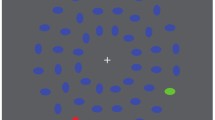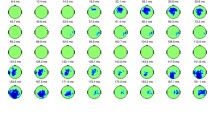Summary
“Whole-head” maps of ERP source densities were recorded at 42 locations, spaced radially at 6 cm in hexagonal arrays, from two human subjects (S) during a visually-guided target-practice task with manual button-pressing and visual feedback, in a series of six or more 9 h recording sessions. From one S a finer-grained map (3 cm spacing) was also obtained at 13 occipital placements. Corresponding results at a smaller number of locations were obtained from nine other Ss. The topographical effects of (a) changing the hand used, (b) reversing the direction and hemifield of target approach, and (c) changing the difficulty of the task were investigated in detail. Only locations near and just anterior to Cz were significantly affected by exchanging hands. Contralateral preparatory negativities, and ipsilateral negativities in anticipation of feedback, were enhanced. Changing the stimulus hemifield mainly affected occipito-parietal locations, with enhancement of contralateral preparatory-phase negativities, and of ipsilateral pre-feedback negativities, both there and near Cz. At certain parietal locations, however, the profiles were unaffected. Increase of task difficulty enhanced the difference between evaluation potentials for success and failure at a few locations, but left the general map largely unaltered. When comparing topographic features of the source-density maps in the two main Ss, the standard 10/20 topographic landmarks proved surprisingly unreliable. For each phase of the task, there were also hemispheric asymmetries not linked to the hand used or the hemifield stimulated; but their topography varied from S to S. Source densities during the preparatory phase were strongest around the vertex, with accompanying activity in parietal as well as occipital areas. No endogenous predictors of success and failure could be seen in the preparatory source-density profile. The source density map of the evaluation potential elicited by feedback suggests a relatively deep location for its generator. The ERP correlates of success and failure differ mainly in their form; amplitude differences vary from S to S. When S participates only imaginatively as a spectator of target practice by others or by machine, the general form of the ERP map is similar over the whole cycle, but amplitudes diminish from rear to front of the head. The cognitive significance of the main ERP features is confirmed by their virtual disappearance, except near the occipital poles, when S's attention is distracted from the significance of the visual input.
Similar content being viewed by others
References
Hillyard SA, Courchesne E, Krausz HI, Picton TW (1976) Scalp topography of the P3 wave in different auditory decision tasks. In: McCallum WC, Knott JR (eds) The responsive brain. Wright and Sons, Bristol, pp 81–87
Jeffreys DA, Axford JG (1972a) Source locations of pattern specific components of human visual evoked potentials. I. Component of striate cortical origin. Exp Brain Res 16: 1–21
Jeffreys DA, Axford JG (1972b) Source locations of pattern specific components of human visual evoked potentials. II. Component of extrastriate cortical origin. Exp Brain Res 16: 22–40
Loveless NE (1979) Event-related slow potentials of the brain as expressions of orienting function. In: Kimmel HD, van Olst EH, Orlebeke JF (eds) The orienting reflex in humans. Erlbaum, Hillsdale, pp 77–100
MacKay DM (1983) On-line source-density computation with a minimum of electrodes. Electroencephalogr Clin Neurophysiol 56: 696–698
MacKay DM (1984a) Source density analysis of scalp potentials during evaluated action. I. Coronal distribution. Exp Brain Res 54: 73–85
MacKay DM (1984b) Source density analysis of scalp potentials during evaluated action. II. Lateral distributions. Exp Brain Res 54: 86–94
MacKay DM (1984c) Do ‘evaluation potentials’ reflect cognitive assessment? Exp Brain Res 55: 184–186
MacKay DM, Rulon MJ (1985) Visuomotor integration reflected in the source-density pattern of human scalp potentials. J Physiol Abstr 360: 31P
MacKay DM, MacKay V, Rulon MJ (1985) Local CNVs for different phases of a cognitive task in man. J Physiol Abstr 367: 24P
Mountcastle VB, Lynch JC, Georgopoulos AP, Sakata H, Acuna C (1975) The posterior parietal association cortex of the monkey: command functions for operations within extrapersonal space. J Neurophysiol 38: 871–908
Mountcastle VB, Andersen RA, Motter BC (1981) The influence of attentive fixation upon the excitability of the light sensitive neurons of the posterior parietal cortex. J Neurosci 1: 1218–1235
Papakostopoulos D (1985) The CNV potentials and adaptive preparatory behaviour (Abstract). Conference on Dynamics of Sensory and Cognitive Processing of the Brain, Berlin
Papakostopoulos D, Crow HJ (1976) Electrocorticographic studies of the contigent negative variation and ‘P300’ in man. In: MacCallum WC, Knott JR (eds) The responsive brain. Wright and Sons, Bristol, pp 201–204
Papakostopoulos D, Crow HJ, Newton P (1980) Spatiotemporal characteristics of intrinsic evoked and event related potentials in the human cortex. In: Pfurtscheller G et al. (eds) Rhythmic EEG activities and cortical functioning. Elsevier/North Holland Biomedical Press, Amsterdam New York, pp 179–200
Srebro R (1985) Localization of visually evoked cortical activity in humans. J Physiol 360: 233–246
Wood CC, Allison T, Goff WR, Williamson PD, Spencer DD (1980) On the neural origin of P300 in man. In: Kornhuber HH, Deecke L (eds) Motivation, motor and sensory processes of the brain: electrical potentials, behaviour and clinical use. Progress in brain research, Vol 54. Elsevier, Amsterdam, pp 51–56
Wood CC, McCarthy G (1985) A possible frontal lobe contribution to scalp P300. Soc Neurosci Abstr 11(2): 879
Author information
Authors and Affiliations
Rights and permissions
About this article
Cite this article
MacKay, D.M., MacKay, V. & Rulon, M.J. Scalp topography of ERP source-densities during visually guided target practice. Exp Brain Res 64, 434–450 (1986). https://doi.org/10.1007/BF00340480
Received:
Accepted:
Issue Date:
DOI: https://doi.org/10.1007/BF00340480




